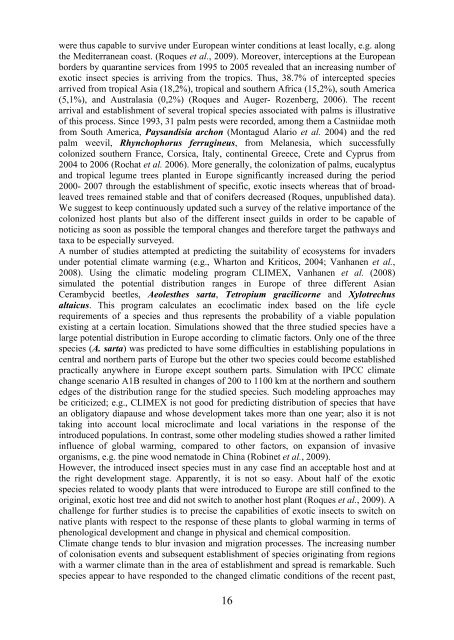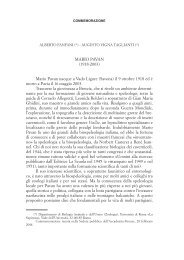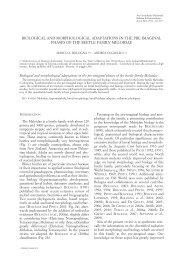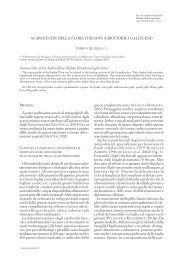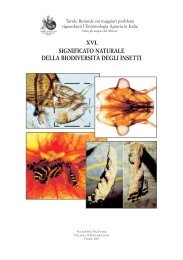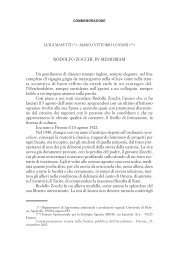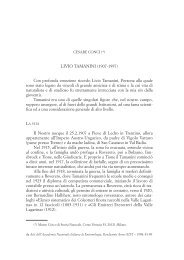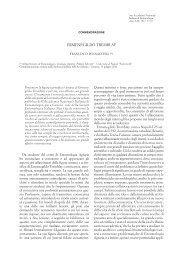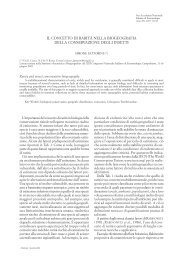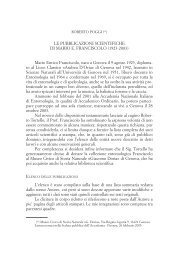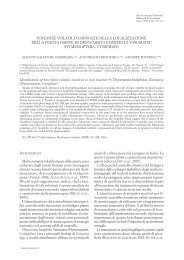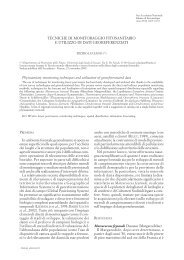XXII CNIE - Accademia nazionale italiana di Entomologia
XXII CNIE - Accademia nazionale italiana di Entomologia
XXII CNIE - Accademia nazionale italiana di Entomologia
You also want an ePaper? Increase the reach of your titles
YUMPU automatically turns print PDFs into web optimized ePapers that Google loves.
were thus capable to survive under European winter con<strong>di</strong>tions at least locally, e.g. along<br />
the Me<strong>di</strong>terranean coast. (Roques et al., 2009). Moreover, interceptions at the European<br />
borders by quarantine services from 1995 to 2005 revealed that an increasing number of<br />
exotic insect species is arriving from the tropics. Thus, 38.7% of intercepted species<br />
arrived from tropical Asia (18,2%), tropical and southern Africa (15,2%), south America<br />
(5,1%), and Australasia (0,2%) (Roques and Auger- Rozenberg, 2006). The recent<br />
arrival and establishment of several tropical species associated with palms is illustrative<br />
of this process. Since 1993, 31 palm pests were recorded, among them a Castniidae moth<br />
from South America, Paysan<strong>di</strong>sia archon (Montagud Alario et al. 2004) and the red<br />
palm weevil, Rhynchophorus ferrugineus, from Melanesia, which successfully<br />
colonized southern France, Corsica, Italy, continental Greece, Crete and Cyprus from<br />
2004 to 2006 (Rochat et al. 2006). More generally, the colonization of palms, eucalyptus<br />
and tropical legume trees planted in Europe significantly increased during the period<br />
2000- 2007 through the establishment of specific, exotic insects whereas that of broadleaved<br />
trees remained stable and that of conifers decreased (Roques, unpublished data).<br />
We suggest to keep continuously updated such a survey of the relative importance of the<br />
colonized host plants but also of the <strong>di</strong>fferent insect guilds in order to be capable of<br />
noticing as soon as possible the temporal changes and therefore target the pathways and<br />
taxa to be especially surveyed.<br />
A number of stu<strong>di</strong>es attempted at pre<strong>di</strong>cting the suitability of ecosystems for invaders<br />
under potential climate warming (e.g., Wharton and Kriticos, 2004; Vanhanen et al.,<br />
2008). Using the climatic modeling program CLIMEX, Vanhanen et al. (2008)<br />
simulated the potential <strong>di</strong>stribution ranges in Europe of three <strong>di</strong>fferent Asian<br />
Cerambycid beetles, Aeolesthes sarta, Tetropium gracilicorne and Xylotrechus<br />
altaicus. This program calculates an ecoclimatic index based on the life cycle<br />
requirements of a species and thus represents the probability of a viable population<br />
existing at a certain location. Simulations showed that the three stu<strong>di</strong>ed species have a<br />
large potential <strong>di</strong>stribution in Europe accor<strong>di</strong>ng to climatic factors. Only one of the three<br />
species (A. sarta) was pre<strong>di</strong>cted to have some <strong>di</strong>fficulties in establishing populations in<br />
central and northern parts of Europe but the other two species could become established<br />
practically anywhere in Europe except southern parts. Simulation with IPCC climate<br />
change scenario A1B resulted in changes of 200 to 1100 km at the northern and southern<br />
edges of the <strong>di</strong>stribution range for the stu<strong>di</strong>ed species. Such modeling approaches may<br />
be criticized; e.g., CLIMEX is not good for pre<strong>di</strong>cting <strong>di</strong>stribution of species that have<br />
an obligatory <strong>di</strong>apause and whose development takes more than one year; also it is not<br />
taking into account local microclimate and local variations in the response of the<br />
introduced populations. In contrast, some other modeling stu<strong>di</strong>es showed a rather limited<br />
influence of global warming, compared to other factors, on expansion of invasive<br />
organisms, e.g. the pine wood nematode in China (Robinet et al., 2009).<br />
However, the introduced insect species must in any case find an acceptable host and at<br />
the right development stage. Apparently, it is not so easy. About half of the exotic<br />
species related to woody plants that were introduced to Europe are still confined to the<br />
original, exotic host tree and <strong>di</strong>d not switch to another host plant (Roques et al., 2009). A<br />
challenge for further stu<strong>di</strong>es is to precise the capabilities of exotic insects to switch on<br />
native plants with respect to the response of these plants to global warming in terms of<br />
phenological development and change in physical and chemical composition.<br />
Climate change tends to blur invasion and migration processes. The increasing number<br />
of colonisation events and subsequent establishment of species originating from regions<br />
with a warmer climate than in the area of establishment and spread is remarkable. Such<br />
species appear to have responded to the changed climatic con<strong>di</strong>tions of the recent past,<br />
16


